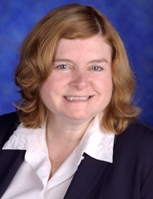
A Wayne State University School of Medicine researcher exploring the use of adult stem cells to treat spinal cord and head injuries has been invited to speak at the University of Notre Dame Law School's inaugural Adult & Alternative Stem Cell Research summer workshop.
Jean Peduzzi-Nelson, Ph.D., associate professor of Anatomy & Cell Biology, will present "The Usefulness of Adult Olfactory Stem Cells in Spinal Cord and Brain Injury" at Notre Dame this week. She is one of the invited speakers for the law school's "Ethical, Philosophical, Legal & Theological Dimensions of Adult & Alternative Stem Cell Research" program.
Dr. Peduzzi-Nelson is working to bring the use of person's own nasal (olfactory mucosal) stem cells to clinical trials for spinal cord and head injuries and radiotherapy-induced brain injury. The process involves the use of adult stem-like progenitor cells in the patient's own nasal tissue. The use of a person's own stem cells lessens the problems of rejection, tumor formation and disease transmission.
"Our studies in rats revealed that functional improvement only occurred when the olfactory stem cells were from rats that were identical genetically," Dr. Peduzzi-Nelson said. "These stem cells can be delivered into the cerebrospinal fluid that surrounds the brain and spinal cord using a routine medical procedure (lumbar puncture) to reach areas of damage. Olfactory mucosa stem cells may be the best method to treat any type of neural injury or disease."
She noted that there are many sources of stem cells in the body, including bone marrow, fat and the brain, but that the olfactory mucosa is the only suitable tissue that can be easily obtained with minimally invasive procedures. The stem-like progenitor cells in the olfactory mucosa are special because they normally form new neurons more rapidly than cells from any other place in the adult nervous system. When such cells are transplanted into chick embryos, she said, the cells can form mature cells of the heart, trunk muscles, liver, brain and spinal cord. This suggests that olfactory stem-like progenitor cells are immature and capable of forming a variety of cell types.
In 2009, the journal Neurorehabilitation and Neural Repair published Dr. Peduzzi-Nelson's "Olfactory Mucosal Autografts and Rehabilitation for Chronic Traumatic Spinal Cord Injury." That study detailed the outcome of adult stem cell grafts in spinal cord injuries and how that procedure led to increased mobility and quality of life for patients participating in the study.
Her study detailed how 20 patients with severe chronic spinal cord injuries received a treatment combination of partial scar removal, transplantation of nasal tissue containing stem cells to the site of the spinal cord injury and rehabilitation. All of the patients had total paralysis below the level of their spinal cord injury before the treatment. The injuries in the study patients were 18 months to 15 years old.
The patients, ages 19 to 37, had no use of their legs before the treatment. One paraplegic treated almost three years after the injury now ambulates with crutches and knee braces. Ten other patients ambulate with physical assistance and walkers (with and without braces). One 31-year-old male tetriplegic patient uses a walker without the help of knee braces or physical assistance.
When the stem cell transplant and scar removal process was combined with an advanced form of rehabilitative training that employs brain-initiated, weight-bearing movement, 13 patients improved in the standard measures used to assess functional independence and walking capabilities.
Those results, Dr. Peduzzi-Nelson said, justify advancing to a larger, controlled clinical trial.